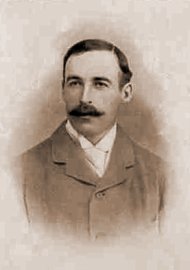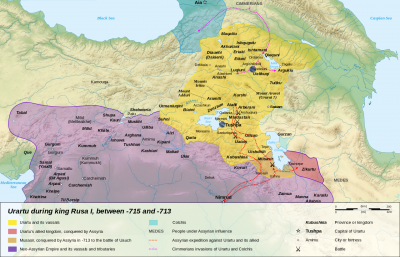Toponym
The toponym Ardjesh possibly derives from the Urartian king Argishti I or the former Urartian royal residence Arzashkun, which was located about 150 kilometers northwest of Lake Van. Until the genocide of 1915, Armenians predominantly inhabited the kaza of Erciş.
Population
 In the early 20th century, the administrative center, called Akants in Armenian, had approximately 1,000 houses, a quarter of these being Armenian. At the end of the 19th century, Henry Finnis Blosse Lynch reported on Akants:
In the early 20th century, the administrative center, called Akants in Armenian, had approximately 1,000 houses, a quarter of these being Armenian. At the end of the 19th century, Henry Finnis Blosse Lynch reported on Akants:
„According to the Kaimakam there are no less than 500 houses in Akantz; but I am inclined to consider this figure excessive. A number among them are well built, with good walls and glass-paned windows (…). The population is partly Mussulman and partly Armenian. I should say that the former have the preponderance, although not in the proportion which was assigned to them by the same authority of four fifths of the whole. The Armenians possess two churches and a school, administered by a priest. Several regiments of Hamidiyeh have their headquarters in the town. They are recruited among the Haideranli and Adamanli Kurds. Their enrolment has been attended by the usual result – a general relaxation of the law. Robberies are committed under the eyes of the Kaimakam, and stealing is scarcely considered an offence. (…)”
Source: Lynch, H.F.B.: Armenia: Travels and Studies. Vol. II (The Turkish Provinces). London: Longmans, Green, and Co. (Reprint Beirut: Khayat, 1965; 1967; 1990, p. 26
Destruction
Raymond Kévorkian summarized the genocidal events in this kaza as follows:
“Located on the northwestern shore of Lake Van, the kaza of Erciş/Arjesh boasted 54 Armenian towns and villages on the eve of the war, with a total population of 10,381. In the administrative seat of the kaza, Agants (2,078 Armenians) the kaymakam, a Young Turk from Istanbul, Ali Rıza Bey, ordered on 19 April 1915 that all Armenian men in the small town gather before the sub-prefecture. Four hundred men were locked up on that day in the town jail. In the evening, the men were bound together in groups of ten and conducted by gendarmes and militiamen toward the lakeport, near the village of Khargen (pop. 285), where they were shot. The same day, 700 to 800 men from the neighboring villages who had been confined in barracks near the town’s southwestern exit met the same fate. (…)
According to A-To (1)[i.e. Hovhannes Ter Martirosian], of the 10,381 Armenians in the kaza, 2,378 had been massacred by 19 April, 518 (for the most part young women and children) had been abducted, 953 had been carried off by disease or starvation, and 693 were missing. This represented 4,542 people, nearly 45 percent of the total Armenian population. The survivors managed to flee northeast behind the Russian lines, which were then situated on the line running through Dyadin.”
Source: Kévorkian, Raymond: The Armenian Genocide: A Complete History. London, New York: I.B. Tauris, 2011, p. 323
“(…) Kurds and Turkish soldiers were horribly hausing in the whole area. They massacred men, women and children and burned down their homes. Young children were shot in the arms of their mothers, others were terribly mutilated, women were robbed of their clothes and beaten. The village of Arjish on the northeast shore of Lake Van suffered particularly severe affliction. First, the Vali of Van, under the pretext of a political consultation, summoned the notables of Akantz, had them arrested and shot all of them. In the village itself, 500 young people were mustered by the gendarmes. At sunset these 500 men were led out of the village without any further formalities and shot. The same thing happened in the next two days in about eighty villages north of Lake Van, and in this way about 24,000 Armenians were killed within three days, the young women taken away and the houses looted.”
Excerpted and translated from: Zurlinden, Samuel: Der Weltkrieg. Vorläufige Orientierung von einem schweizerischen Standpunkt aus. Vol. 2. Zürich: Art. Institut Orell Füssli, 1918
Ardjesh (Town) – Արճեշ
Ardjesh belonged from the early 12th to the early 13th century to the principality of the Ahlat (Akhlat) Shahs and was later the capital of the Kara Koyunlu. From the 18th century onwards the Old Town (historically Ardjesh) slowly disappeared due to the rise of Lake Van. After a flood in 1841, Ardjesh was moved to Alada, to a higher place in the north. The newly built city was called Akants or New Ardjesh (Նոր Արճեշ). At the beginning of the 20th century, the population of the kasaba Erciş consisted of 1,490 Armenians, 630 Muslims and 60 Jews.
“Little is left above ground of the once important borough of mediaeval repute. The crumbling walls of a castle, a ruined chapel, a minaret are the principal monuments still erect. The method of building is that of a more cultural age. A recent fire had converted the brushwood into black patches. (…) Arjish played an important part in the history of the Middle Ages; and there can be no doubt that these ruins are those of the mediaeval city. On the other hand it is quite possible that the name Arsissa, under which Lake Van was known to Ptolemy, may be connected with a much more ancient Arjish, which may well have been stood on the high land overlooking the modern town of Akantz.”
Source: Lynch, H.F.B.: Armenia: Travels and Studies. Vol. II (The Turkish Provinces). London: Longmans, Green, and Co. (Reprint Bekkirut: Khayat, 1965; 1967; 1990, p. 27
